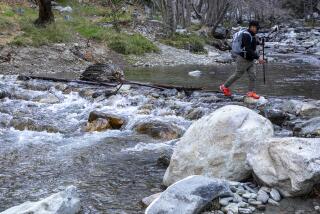Rangers Support Controlled Burns to Prevent Disasters
DARBY, Mont. — With one-quarter of his forest district blackened by wildfires, ranger Craig Bobzien has a surprising attitude: He’d be glad to see more fires. In fact, he hopes to have government crews light some.
Not at the moment, of course. Firefighters here and throughout the West are waging an all-out war to contain this summer’s devastating wildfires and divert them from populated areas.
But Bobzien and other U.S. Forest Service officials say the dense timber and brush clogging many Western forests has to burn at some point, and they’d rather have it happen in a controlled manner than in the kind of explosive, dangerous wildfires raging now.
The government’s program for such “prescribed burns” got a black eye in May, after a fire set to control brush at Bandelier National Monument in New Mexico blew out of control and destroyed more than 200 homes in Los Alamos. Critics assailed the practice as unnecessarily dangerous.
Yet Bobzien, district ranger for the Darby ranger district of the Bitterroot National Forest, said that if foresters had been allowed to set more prescribed burns in recent years, this year’s destruction could have been far less severe.
“We’re growing biomass faster than it’s being consumed,” Bobzien said, standing in a firefighters’ camp shrouded in smoke from lightning-sparked fires that have charred about 130,000 acres of his 500,000-acre district in the Bitterroot Valley of southwestern Montana.
Throughout the West, foresters are dealing with the fallout from decades of suppressing fires to protect public safety and preserve timber for loggers.
“I liken it to stacking firewood in your fireplace but not lighting it,” said Dave Campbell, district ranger on the Bitterroot’s West Fork ranger district. “When you finally do light it, it burns more intensely. It’s a question of pay me now or pay me later.”
In recent years, foresters have embraced the idea of burning to mimic nature’s ways, but they’ve encountered resistance. While most Westerners accept the ecological importance of fire in theory, actually setting blazes is another matter.
Local residents complain about the smoke that can hang in the valley for days. Congress does not allocate enough funds to do the burns that forest officials say are needed. There are narrow windows in spring and fall when the forest will burn without burning out of control. And the timber industry wants more trees thinned by logging rather than by burning.
“The notion that you can go into these forests with prescribed burns, without taking out some of the fuels first, is just plain foolish,” said Cary Hegreberg, executive vice president of the Montana Wood Products Assn.
“I don’t care if they light them in March, April or October. They’re not going to be able to control them,” he said. “Their own science points to the need to remove some of the fuels, yet their internal politics seems to be impeding their common sense. On the Bitterroot National Forest, there has been very little timber--that’s fuel--removed from the forest in the last 10 years.”
More to Read
Sign up for Essential California
The most important California stories and recommendations in your inbox every morning.
You may occasionally receive promotional content from the Los Angeles Times.










